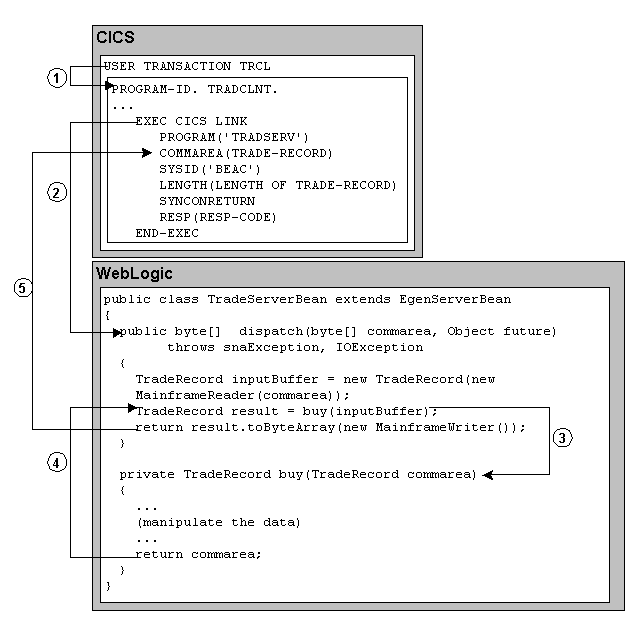

| Download Docs | |
|
| bea.com | products | dev2dev | support | askBEA |
 |
 |
|
| e-docs > WebLogic Java Adapter for Mainframe > Programming Guide > Understanding Programming Flows |
|
Programming Guide
|
Understanding Programming Flows
This section illustrates the interaction between WebLogic Server and mainframe programs. The following topics are discussed:
Distributed Program Link Programming Flows
The following examples of DPL programming flows are discussed:
Java Client Request/Response to CICS DPL
Figure 5-1 illustrates a Java Client Request/Response to CICS DPL programming flow.
Figure 5-1 Java Client Request/Response to CICS DPL
The following steps describe the Java Client Request/Response to CICS DPL programming flow.
CICS Request/Response DPL to WebLogic Server EJB
Figure 5-2 illustrates a CICS request/response DPL to WebLogic Server EJB programming flow.
Figure 5-2 CICS Request/Response DPL to WebLogic Server EJB
The following steps describe the CICS request/response DPL to WebLogic Server EJB programming flow.
CICS DPL Asynchronous No Reply to WebLogic Server Application
Figure 5-3 illustrates a CICS DPL asynchronous no reply to Java server programming flow.
Figure 5-3 CICS DPL asynchronous no reply to Java server
The following steps describe the CICS DPL asynchronous no reply to Java server programming flow.
Transactional Java Client Request/Response to CICS DPL
Figure 5-4 illustrates a transactional Java client request/response to CICS DPL programming flow.
Figure 5-4 Transactional Java Client Request/Response to CICS DPL
The following steps describe the transactional Java client request/response to CICS DPL programming flow.
Transactional CICS Request/Response DPL to WebLogic Server EJB
Figure 5-5 illustrates a transactional CICS request/response DPL to WebLogic Server EJB programming flow.
Figure 5-5 Transactional CICS Request/Response DPL to WebLogic Server EJB
The following steps describe the transactional CICS request/response DPL to WebLogic Server EJB programming flow.
IMS Implicit APPC Programming Flows
The following examples of IMS implicit APPC programming flows are discussed:
Java Client Request/Response to IMS Transaction Program
Figure 5-6 illustrates a Java Client Request/Response to IMS programming flow.
Figure 5-6 Java Client Request/Response to IMS Transaction Program
The following steps describe the Java Client Request/Response to IMS programming flow.
IMS Asynchronous No Reply Transaction Program to Java Server
Figure 5-7 illustrates an IMS asynchronous no reply transaction program to a Java server programming flow.
Figure 5-7 IMS Asynchronous No Reply Transaction Program to Java Server
The following steps describe the IMS transaction program to asynchronous no reply Java Server programming flow.
Listing 5-1 IMS PSBGEN for a Modifiable Alternate PCB for the IMS Client
PCB TYPE=TP,MODIFY=YES
PSBGEN PSBNAME=IMSTOJMS,CMPAT=YES,LANG=COBOL
Note: The logical terminal name, in this case JAMIMS01, must be mapped to an LU name and a transaction name in a LU 6.2 Descriptor. In Listing 5-2, JAMIMS01 is mapped to the LU CRMLU and the transaction ITOJMSSV.
Listing 5-2 LU 6.2 Descriptor
A JAMIMS01 LUNAME=CRMLU TPNAME=ITOJMSSV SYNCLEVEL=N
Transactional Java Client Request/Response to IMS Transaction Program
Figure 5-8 illustrates a transactional Java client request/response to an IMS transaction programming flow.
Figure 5-8 Transactional Java Client Request/Response to an IMS Transaction Program
The following steps describe the transactional Java client request/response to IMS transaction programming flow.
Common Programming Interface for Communications Programming Flows
The following examples of CPI-C programming flows are discussed:
Java Client Request/Response to Host CPI-C
Figure 5-9 illustrates a Java client request/response to a host CPI-C programming flow.
Figure 5-9 Java Client Request/Response to Host CPI-C
The following steps describe the Java client request/response to host CPI-C programming flow.
Host CPI-C Request/Response to WebLogic Server EJB
Figure 5-10 illustrates a host CPI-C request/response to WebLogic Server EJB programming flow.
Figure 5-10 Host CPI-C Request/Response to WebLogic Server EJB
The following steps describe the host CPI-C request/response to WebLogic Server EJB programming flow.
Host CPI-C Asynchronous No Reply to Java Server
Figure 5-11 illustrates a Host CPI-C asynchronous no reply to Java server programming flow.
Figure 5-11 Host CPI-C Asynchronous No Reply to Java Server
The following steps describe the Host CPI-C asynchronous no reply to Java server programming flow.
Transactional Java Client Request/Response to Host CPI-C
Figure 5-12 illustrates a transactional Java client request/response to a Host CPI-C programming flow.
Figure 5-12 Transactional Java Client Request/Response to a Host CPI-C
The following steps describe the transactional Java client request/response to a host CPI-C programming flow.
Transactional Host CPI-C Request/Response to WebLogic Server EJB
Figure 5-13 illustrates a transactional host CPI-C request/response to WebLogic Server EJB programming flow.
Figure 5-13 Transactional Host CPI-C Request/Response to WebLogic Server EJB
The following steps describe the transactional host CPI-C request/response to WebLogic Server EJB programming flow.

|

|

|